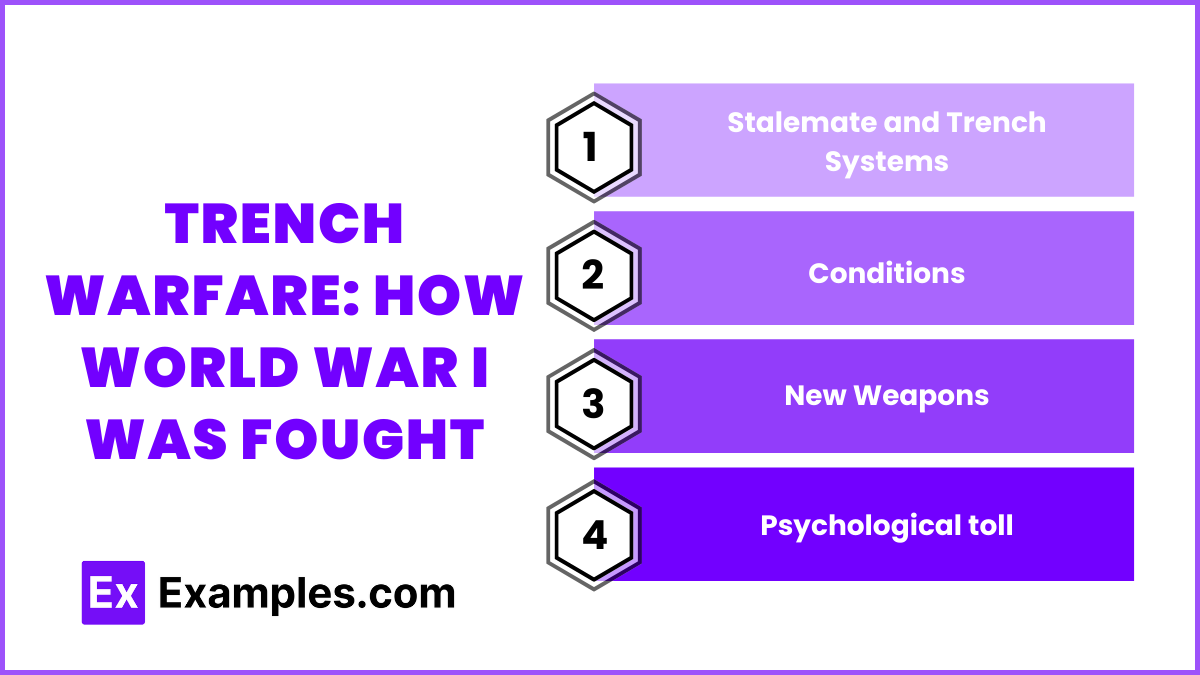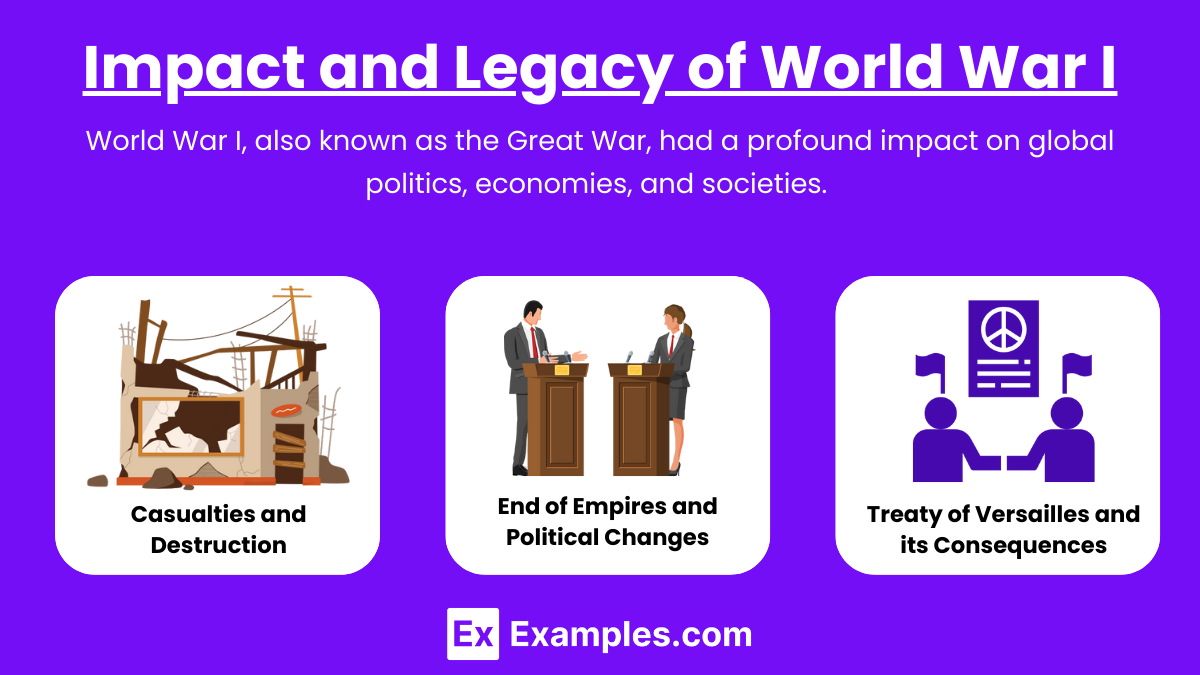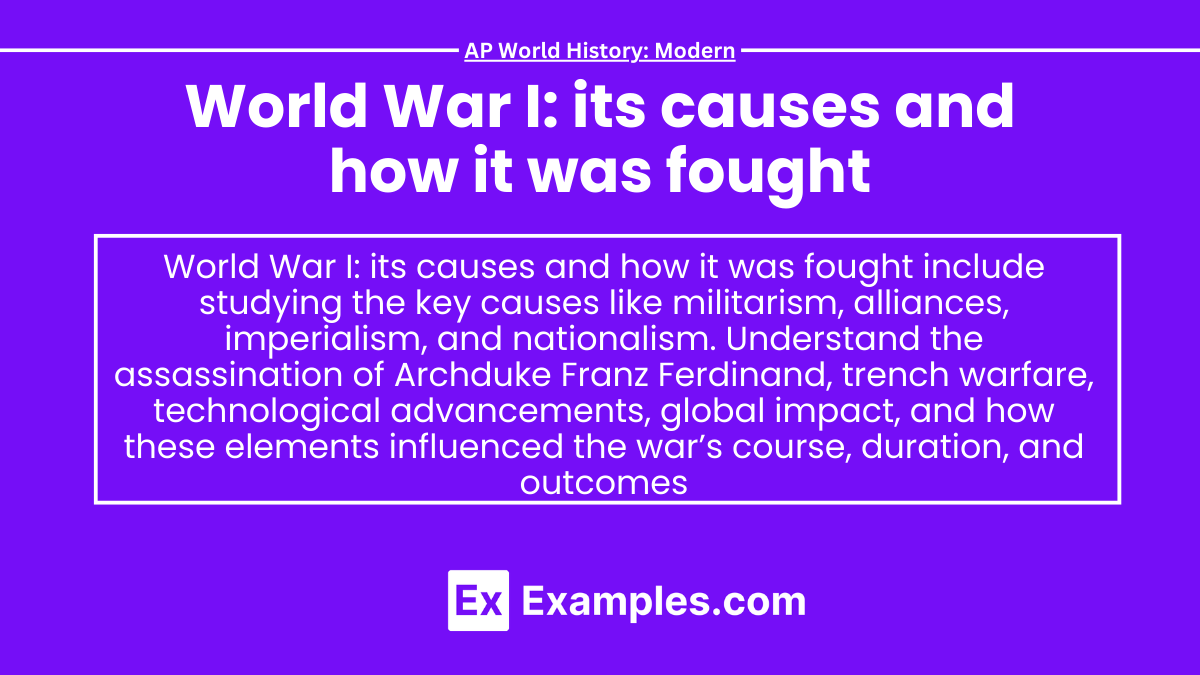World War I: its causes and how it was fought, marked a significant turning point in modern history. Triggered by militarism, alliances, imperialism, and nationalism, the conflict erupted after the assassination of Archduke Franz Ferdinand in 1914. Fought with trench warfare, poison gas, tanks, and machine guns, World War I resulted in massive casualties and reshaped global political landscapes.
Learning Objective
In studying “World War I: Its Causes and How It Was Fought” for AP World History: Modern, you should learn to identify the key causes of the war, analyze military strategies and technologies, and evaluate the global impact of the conflict on societies.
1. Causes of World War I: The MAIN Factors

- Militarism: European powers expanded their military capabilities, creating an arms race that heightened tensions. Nations like Germany and Britain engaged in naval expansion, while armies across the continent grew in size and technology.
- Alliances: Complex alliances like the Triple Alliance (Germany, Austria-Hungary, Italy) and the Triple Entente (France, Russia, Britain) meant that any conflict involving one country could rapidly involve others, escalating into a larger war.
- Imperialism: Competition for overseas colonies created rivalries, particularly in Africa and Asia. This competition fueled nationalistic fervor and distrust among European powers.
- Nationalism: Intense national pride and desires for independence among various ethnic groups, especially in the Balkans, contributed to an environment ripe for conflict. The assassination of Archduke Franz Ferdinand of Austria-Hungary by a Serbian nationalist triggered the war.
2. The Outbreak of World War I: The July Crisis and Declarations of War

- The assassination of Archduke Franz Ferdinand on June 28, 1914, set off a chain reaction. Austria-Hungary, backed by Germany, issued an ultimatum to Serbia. Serbia’s response failed to satisfy Austria-Hungary, leading to a declaration of war on July 28, 1914.
- Russia mobilized in support of Serbia, prompting Germany to declare war on Russia. As alliances activated, Germany declared war on France and invaded Belgium, drawing Britain into the conflict. By August 1914, most of Europe was at war.
3. Trench Warfare: How World War I Was Fought

- Stalemate and Trench Systems: The Western Front, stretching from the North Sea to Switzerland, saw entrenched armies facing each other across no man’s land. Trench warfare led to a stalemate, with little territorial gain despite heavy losses.
- Conditions: Soldiers lived in harsh conditions, enduring mud, rats, disease, and the constant threat of enemy attack. The trenches provided some protection but also contributed to the spread of illness and low morale.
- New Weapons: The use of machine guns, artillery, poison gas, tanks, and airplanes revolutionized warfare. These technologies made frontal assaults deadly and contributed to the high casualty rates, but they also often proved ineffective in breaking the stalemate.
- Psychological toll: Trench warfare contributed to high casualties and significant trauma among soldiers.
5. Impact and Legacy of World War I

World War I, also known as the Great War, had a profound impact on global politics, economies, and societies. Its legacy shaped the 20th century, leading to significant territorial changes, the rise of new ideologies, and lasting international conflicts.
- Casualties and Destruction: World War I resulted in unprecedented destruction and loss of life, with approximately 16 million deaths (both military and civilian) and countless wounded. The war devastated large parts of Europe, leading to economic hardship and political instability.
- End of Empires and Political Changes: The war led to the collapse of empires (Austro-Hungarian, Ottoman, Russian, and German) and the redrawing of national borders, planting seeds for future conflicts.
- Treaty of Versailles and its Consequences: The war officially ended with the Treaty of Versailles in 1919, which imposed harsh penalties on Germany. The treaty’s punitive measures and unresolved grievances contributed to the rise of extremism and eventually to World War II.
Examples
Example 1: Militarism Leading to Conflict
Germany and Britain’s naval arms race fueled suspicion and hostility, as each nation built powerful battleships to outdo the other. This readiness for war made conflict inevitable.
Example 2: The Assassination of Archduke Franz Ferdinand
The assassination of Archduke Franz Ferdinand by a Bosnian Serb nationalist in 1914 triggered a diplomatic crisis, escalating due to alliances into a global conflict involving multiple nations.
Example 3: Trench Warfare and the Battle of the Somme
The Battle of the Somme in 1916 exemplified the brutality of trench warfare, with soldiers facing horrific conditions and high casualties, resulting in little territorial gain despite massive offensives.
Example 4: Germany’s Unrestricted Submarine Warfare
Germany’s U-boat attacks on Allied and neutral ships, including the sinking of the RMS Lusitania, provoked international outrage and contributed to the United States joining the war in 1917.
Example 5: The Use of Poison Gas at the Second Battle of Ypres
Germany’s deployment of chlorine gas at Ypres in 1915 marked the first large-scale use of chemical weapons, highlighting the war’s technological evolution and devastating effects on soldiers.
MCQs
Question 1
Which of the following was a direct trigger for the outbreak of World War I?
A) The sinking of the RMS Lusitania
B) The assassination of Archduke Franz Ferdinand
C) The signing of the Treaty of Versailles
D) The rise of Adolf Hitler
Answer: (B) The assassination of Archduke Franz Ferdinand
Explanation: The assassination of Archduke Franz Ferdinand by a Serbian nationalist in 1914 directly triggered World War I. Austria-Hungary’s declaration of war on Serbia led to a domino effect, involving allied nations. The other options were significant but not the immediate cause.
Question 2
Which of the following best describes the nature of warfare on the Western Front during World War I?
A) Rapid advances by both sides
B) Guerrilla warfare and hit-and-run tactics
C) Trench warfare and stalemates
D) Large-scale naval battles
Answer: (C) Trench warfare and stalemates
Explanation: Trench warfare characterized the Western Front, with soldiers fighting from extensive trench networks. This led to a prolonged stalemate with minimal territorial gains, making the war a deadly and grueling conflict. Other options inaccurately describe the primary warfare nature.
Question 3
Which of the following alliances were involved at the beginning of World War I?
A) NATO and the Warsaw Pact
B) The Triple Alliance and the Triple Entente
C) The Axis Powers and the Allies
D) The League of Nations and the United Nations
Answer: (B) The Triple Alliance and the Triple Entente
Explanation: The Triple Alliance (Germany, Austria-Hungary, Italy) and the Triple Entente (France, Russia, Britain) were the main alliances at World War I’s start. These alliances escalated the conflict. Other options are from different periods or contexts.


